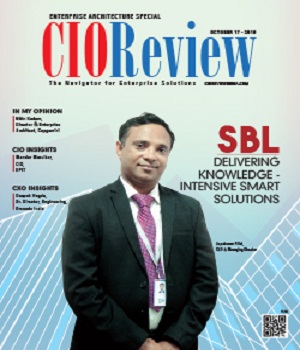
Just Enough Architecture, Just in Time
Vijay Bhat, CIO, Head IT & SAP, Vacmet India
 Enterprises globally are undergoing business transformation. Organisations and corporate world have been searching for ways to enhance their businesses in order to be agile and how development in information technology (IT) can help them achieve this in today’s unstable economic climate. Large-scale changes in the business affect operations, which in turn impact business systems. Changes in the underlying technology infrastructure are often needed to enable business transformation. The study carried out shows that architecture is the key to managing complexity and scale of change in the business. The method used is the integration of the processes for strategic, business, operations, systems and technology planning in a way that also integrates with other business and technology governance processes. Enterprise Architecture provides a framework to describe, manage and align the various elements of an organisation such as business processes, information, applications and technology and enables to understand the relationships between these elements and their environment to better facilitate change.
Enterprises globally are undergoing business transformation. Organisations and corporate world have been searching for ways to enhance their businesses in order to be agile and how development in information technology (IT) can help them achieve this in today’s unstable economic climate. Large-scale changes in the business affect operations, which in turn impact business systems. Changes in the underlying technology infrastructure are often needed to enable business transformation. The study carried out shows that architecture is the key to managing complexity and scale of change in the business. The method used is the integration of the processes for strategic, business, operations, systems and technology planning in a way that also integrates with other business and technology governance processes. Enterprise Architecture provides a framework to describe, manage and align the various elements of an organisation such as business processes, information, applications and technology and enables to understand the relationships between these elements and their environment to better facilitate change.
Enterprise architecture has grown from being just a set of small pilots to being a fully sponsored and supported initiative within enterprises. With the growing demands to reduce costs, increase agility, and standardize IT environments, there has been a surge of enterprise architecture activity. The term “enterprise architecture” can have many different meanings, and we often find that there are only particular aspects examined. To compound the issue, information technology professionals scope enterprise architecture differently. Some IT professionals view enterprise architecture as a more structured activity with many moving parts such as architecture strategy, architecture patterns, principles, architecture design, business architecture, and IT governance.
The bottom line: more cost, less value. These problems, first recognized 29 years ago, have today reached a crisis point. The cost and complexity of IT systems have exponentially increased, while the chances of deriving real value from those systems have dramatically decreased.
Today’s bottom line: even more cost, even less value. Large organizations can no longer afford to ignore these problems. The field of enterprise architecture that 20 years ago seemed quaintly quixotic today seems powerfully prophetic.
Many will argue that my definition is not exhaustive enough. I disagree. In my definition, the goal of an enterprise is not to completely document every business process, every software system, and every database record that exists throughout the organization. Instead, my definition assumes a much more pragmatic goal: finding opportunities to use technology to add business value.
If adding business value is not the ultimate goal of enterprise architecture, then the energy put into creating that enterprise architecture has been badly misplaced. If one can achieve this goal without going through a costly, time-consuming process, then I say, "so much the better."
For many enterprise architects, there is increasing pressure from CxOs to cut costs, reduce inefficiencies, and to foster agility in systems. Enterprises invest more than 70 percent of their budgets purely on maintaining their existing asset investments. This shows that there is a clear and present broken link between strategic business objectives and “keeping the lights on” in the IT department. This is verified by researches that reports that 75 percent of IT organizations have little oversight over their project portfolios and employ non-repeatable, chaotic planning processes.
For many enterprise architects, there is increasing pressure from CxOs to cut costs, reduce inefficiencies, and to foster agility in systems. Enterprises invest more than 70 percent of their budgets purely on maintaining their existing asset investments. This shows that there is a clear and present broken link between strategic business objectives and “keeping the lights on” in the IT department. This is verified by researches that reports that 75 percent of IT organizations have little oversight over their project portfolios and employ non-repeatable, chaotic planning processes.
There are several reasons why we should consider the use of an EA framework:
• An enterprise is a very complex entity. Good frameworks simplify the complexity of the entity they represent.
• EA needs to present a simplified version of that complexity for analysis,communicationand deliverables. Simplification of the enterprise into its elements will be a tremendous aid in breaking down areas of analysis, communicating with technical and non-technical audiences, and deciding which types of deliverables to create and how to categorize them.
• Frameworks help to organize the huge number of complex elements and relationships that make up an enterprise.
• Highlights all the areas to consider for the scope of wer EA. One of the biggest challenges for many enterprise architects is defining the scope of the EA.
Similarly there are several reasons why we should NOT consider the use of an EA framework:
• Process. Process. Process. The process that is used to develop an EA program, develop the EA deliverables, and then integrate EA into the decision making fabric of the enterprise is more important than the framework we choose or the tools that we use.
• We must think thoroughly through all aspects of wer EA for wer Enterprise – Do not let frameworks do this! A framework really helps in thinking through the topical, functional, operational elements of the enterprise.
• Our Goals & Objectives must drive WHAT we do and WHAT we model – not a framework. The most important driver of what we do in any given iteration of wer EA process is the set of goals and objectives we are trying to meet.
• “Just enough architecture, just in time” Being pragmatic is one of the most critical characteristics of an effective enterprise architect.
CIO Viewpoint
Why Foolproof Facial Recognition Is Key Against...
By Joseph Sudheer Thumma, Global CEO & MD, Magellanic Cloud
National Technology Day 2025: Powering Progress...
By CIOTech Outlook Team
Aligning IT Roadmap with Business Objectives: A...
By Subhash singh Punjabi, CISO & Head Enterprise Architecture, Deepak Fertilisers & Petrochemicals Corporation Ltd
CXO Insights
SBL: Delivering Knowledge - Intensive Smart...
By CIOReview Team
The Architect - Guiding Principles
By Leo Barella, VP & Chief Enterprise Architect, AstraZeneca
Mobile Operators Need a Scalable Cost-Effective...







